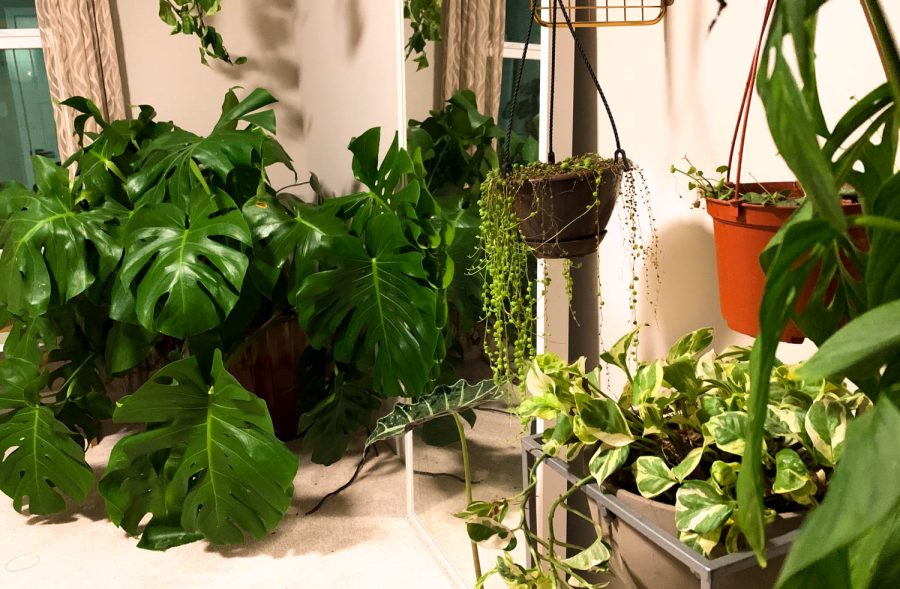Think Green
Adding some greenery to your house offers health and wellness benefits, if you’re up to the challenge.
Houseplants bring many benefits to both your physical and mental wellbeing.
I feel no shame in being a self-proclaimed plant prophet, and I don’t think I ever will.
You may wonder why I feel such a strong inclination to claim some connection to the divine spirits driving the house plant scene, but I have quite a history of persuading people to take the jump to get their hands dirty and their thumbs green.
I have 34 plants in my room alone. Perhaps one could call it an obsession, and I would not necessarily disagree, but my fascination is also an investment into my own wellbeing.
Simply put, house plants are great for our health.
But we’ve known this for ages — that plants emit oxygen and absorb carbon dioxide, the exact opposite of our respiratory system, and wonderful for the oxygen content of the air we breathe — but what you may not have been aware of, however, is that plants also absorb harmful airborne toxins as well. According to a study done at NASA, house plants can eliminate up to 87% of air toxins in just one day. Especially at home where air fresheners, cleaning product particles, dust, and mold run rampant in the air we breathe, plants can neutralize most toxins more efficiently than the standard air filter ever could.
Plants can not only prevent illnesses — they can make it a lot easier to recover and heal. When your brain is getting the oxygen it needs and the air in your lungs is growing exponentially cleaner, your body has the resources to better support the immune system and its functions.
Other studies have also shown that plants can improve concentration and productivity by up to 15%. When our air is cleaner and has a higher oxygen concentration, our brains simply function better. There is even a growing evidence base that houseplants can improve a person’s capacity for creative thinking and problem solving.
In my experience, taking care of my plants has become meditative. There is something about spending my Sunday afternoon with a watering can and pruning shears that relaxes me in ways I can’t fully explain.
Sometimes plants die, and quite frankly there isn’t always a whole lot that can be done about it. Unfortunately, many people avoid getting plants in case the plants die, swearing off owning them altogether because they think their thumbs simply aren’t green enough. Even so, the concern of possibly killing a few plants should not be enough to deter anyone from trying to improve the quality of their life.
Finding the right plant is extremely difficult, especially if you don’t know what the plant needs and how many of those needs you are able to meet. Knowing what plants work best in the space you have makes a huge difference, and it’s actually pretty easy to figure out.
When buying plants, it’s important to know a few things first: which way your windows are facing and how many hours of direct sunlight they get are among the most important. Knowing what kind of light and the intensity of it is very important when considering not only the types of plants that are ideal for the space but also where they can be placed based on their needs. It’s also important to acknowledge how much time you want to spend on your plants. Personally, I don’t mind dedicating a portion of my Sunday afternoon solely to plant care, but some people may want to care for their plants only once or twice a month.
Every plant has different needs, and to keep them alive, it’s important to give them a quick search on your phone before taking them home. Plants like the Sill ZZ and snake plants thrive in any amount of light and infrequent watering schedules, but other plants can require heavy direct sunlight and strict watering schedules. But one way to work around this is knowing what signs your plant will give you when it isn’t doing well. A little internet research is all it takes to properly care for your houseplant.
Plants aren’t going to wave their leaves around and shoot you a text message saying the sunlight is frying their chloroplasts, but they do very specific things depending on what’s going on. Plants in the pothos and philodendron families are easy plants to learn with for two main reasons: if they aren’t properly watered or receive the wrong amount of sunlight, you’ll know.
When plants are overwatered, oftentimes their leaves will turn yellow and limp. If they are under watered they will droop, turn brown, or begin to shrivel up. When there is too much sunlight they can start to get brown spots on their leaves or decay from the main part of the leaf, but if there is not enough sunlight, they will often begin falling off or turning brown at the base of the stem.
While I never recommend ordering plants online, websites like The Sill also have plant care articles and tips on how to take care of them or even help you decide what is right for your space. They can even give you suggestions on plants that are pet safe, easy to care for, or don’t require a lot of light.
Local places like Soergel Orchards, have quite the variety of plants, but if you want more personalized advice or consultations, there are smaller plant shops all over Pittsburgh. One of my favorite places is a boutique in Lawrenceville called City Grows, which offers some of the best plant expertise in the area.
And once life returns to normal and we rekindle our social relationships, consider treating yourself to a walk around Phipps Conservatory with a few friends.
Just remember, health is wealth, so go get a little more green in your life.

Julia is a senior at NASH and is delighted to be this year's Photography Editor. She uses she/they pronouns and is passionate about making a positive change in the world. In her spare time she enjoys reading about philosophy, photographing the world, creating art, writing, and caring for her plants. She hopes to become a helicopter pilot one day and dreams of going to school in New Zealand.


